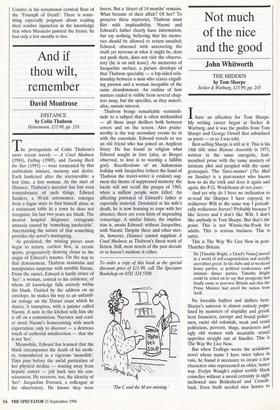Restored to glory
David Ekserdjian MASACCIO by John T. Spike
Abbeville/John Murray, £72, pp. 256
The cleaning of the Sistine Chapel ceil- ing was without question the most talked about restoration of the 1980s. Those in favour — as I am — and those against were only able to agree about one thing: Michelangelo's frescoes were changed utterly. The spotlight of publicity on the Vatican, which was anyway part of the deal they struck with the Japanese, had the unintended effect of sparing the Brancacci Chapel, which was being restored more or less concurrently, although even there Adam and Eve's fig-leaves in Masaccio's 'Expulsion' were cleaned off on live television (they should have been left on). For the rest, the Chapel was closed off to the public in such a way that a casual visitor to the Carmine in Florence could not even sneak a glimpse of how the work was progressing. I consider myself excep- tionally fortunate to have clambered about on the scaffolding with a chain-smoking restorer, after going through the surreal experience of making an appointment by telephoning the Chapel itself.
In the wake of the unveiling, English readers have been positively bombarded with heavy-duty tomes on the Chapel itself, Masaccio and Masolino, Masolino alone, and now Masaccio alone. No doubt, in theory, there must come a point when new- comers to the fray are doing little more than arbitrating between the conflicting opinions of previous scholars, but that point has not yet been reached. John Spike, who is perhaps best known as a specialist on Italian baroque painting, is perfectly conversant with the field, but at times reveals an outsiderish capacity to look at old problems with fresh eyes.
Given how deeply unsatisfactory it is to count a substantial fresco and a small panel as one and the same in a listing of an artist's works, it is impossible — as well as question-begging — to try to decide which great artist has left the smallest oeuvre. It nevertheless remains the case that Masac- cio, whose known career lasted a mere six years, and whose frescoes in the Brancacci Chapel were spared in a disastrous fire that destroyed most of the surrounding church, cut things remarkably fine. Vasari's praises
guaranteed his posthumous reputation, but apart from a few bits and pieces, his only other works are the gauche early triptych from San Giovenale, which no one would have dared attribute to him were it not dated, the 'St Anne', on which he collabo- rated with Masolino, the Pisa altarpiece, of which the central Madonna is in the National Gallery, together with a panel from another joint effort with Masolino, and the stupendous fresco of the Trinity in Santa Maria Novella, the bottom element of which was only uncovered after the last war. Junkshop fantasists should take note of the fact that four full-length and two half-length saints from the Pisa altarpiece are untraced, but it is disheartening to realise that the last element to be rediscov- ered popped up nearly a century ago.
What Spike has to say is well worth read- ing, especially when he is presenting a new thesis concerning which parts of the 'Rais- ing of Theophilus' Son' are by Masaccio (less than we thought), but the format of the book is less satisfactory. The Bellman in The Hunting of the Snark may have believed that saying things three times made them true, but there seems no good reason for the inevitably repetitious divi- sion of this book. It starts with an essay, which is then followed by quite a detailed commentary on the individual colour
plates, and the book is rounded off by a catalogue raisonnd. No doubt this arrange- ment works well for other volumes in the loose series to which this monograph belongs, because the middle section in par- ticular allows the author to single out high- lights from the artist's oeuvre, but in the case of Masaccio there are scarcely enough works to go round. Furthermore, the need to fill up the pages has resulted in a glut of larger than life-size details, which are inherently misleading and at the very least should carry a health warning. Presumably book designers adore them, and would be unmoved by protests to the effect that they show more — which in this context really is less — than the artist intended.
Another, final carp: why does the cata- logue section fail qo record inscriptions? Most of these are admittedly insignificant, but the one in the 'St Anne', which appears to describe her as the head of the Virgin, is revealing of the picture's meaning. Similar- ly, the text at the base of the 'Trinity', which is to be imagined as addressed by the skeleton to the spectator ('I was once what you now are; one day you will be what I now am') is of the greatest importance. Whether proverbial or derived from an earlier written source, these words are not unique to Masaccio: Vasari records an almost exact repetition of them by Piero di Detail of St Peter Raising the Son of Theophilus and St Peter Enthroned as First Bishop of Antioch, Brancacci Chapel, Santa Maria del Carmine, Florence, 1425-26
Cosimo in his sensational carnival float of the 'Triumph of Death'. There is some- thing especially poignant about reading their sombre injunction in the knowledge that when Masaccio painted the fresco, he had only a few months to live.



















































































 Previous page
Previous page